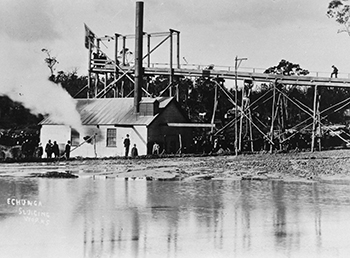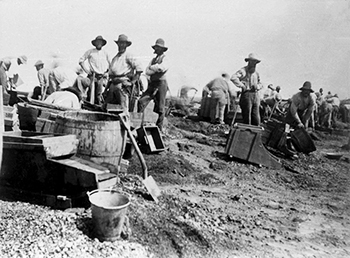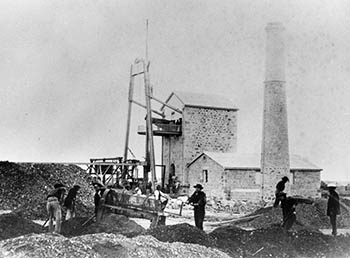1846 to 1900
The first recorded production of gold in South Australia was in 1846 from the Victoria Mine near Castambul, 18 km northeast of Adelaide. The discovery of rich specimens caused great excitement but the mine failed to live up to expectations; less than 1 kg of bullion was produced and interest soon waned.

Echunga sluicing works
The history of subsequent discoveries is characterised by a series of short periods of high gold production as large numbers of men rushed to, and quickly exhausted, each new find. These gold rushes had a significant effect upon population movements within the state, although not as marked as mineral discoveries elsewhere, such as the Victorian gold rushes of the early 1850s, which drew large numbers of men from South Australia.
In 1851, the South Australian Government offered a £1000 reward for the discovery of a payable goldfield. The first claim to this reward was by Messrs Chapman, Hardiman and Hampton following the discovery of alluvial gold near Echunga early in 1852; other discoveries in the vicinity followed. Chapmans Gully (the site of the original find) and Donkey Gully saw the most concerted mining efforts, particularly during the period 1852–58.
Late in 1852 the Adelaide pound was the first Australian gold coin minted. This enabled South Australians to exchange their gold for bank notes which were used for trade.
The discovery nearby of the Jupiter Creek alluvial diggings by Messrs Plane and Saunders in 1868 led to another period of intensive activity. Estimated production from the Echunga Goldfield, the state’s most productive, is about 6000 kg.
The Barossa Goldfield was discovered in late 1868 when a prospecting party led by Job Harris found alluvial gold in Spike Gully, south of Sandy Creek. About 3100 kg were recovered. Further discoveries followed at Para Wirra (1869), Birdwood and Ulooloo (1870), Waukaringa (1873) and Woodside (1879).
Sporadic prospecting was also centred on the Peake and Denison Inliers following the discovery of alluvial gold at Algebuckina on the Neales River in 1870.

Teetulpa Goldfields
The discovery of rich lead-zinc-silver lodes in New South Wales at Silverton and, subsequently, the massive high-grade Broken Hill orebody, led to completion of the railway from Peterborough to Cockburn in 1887. This aided the efforts of prospectors in the Olary region and contributed to discoveries of gold at Manna Hill (1885), Teetulpa (1886), Kings Bluff (1887), Wadnaminga (1888) and Mount Grainger (1891). The discovery of gold-bearing alluvial deposits at Teetulpa by Messrs Brady and Smith in October 1886 saw 5000 miners on the field within two months. The field was virtually deserted by 1889 after having produced an estimated 3100 kg.
Gold was discovered in the Tarcoola area by a shearing-shed hand and prospector named Nichols in October 1893. The attention of other prospectors was drawn to the area and further discoveries were made.
1900 to 1976

Hughes Enginehouse, Moonta
The Tarcoola Goldfield was worked from 1900 to 1912 and sporadically thereafter until the present day. Total recorded production is 2400 kg. The nearby Glenloth Goldfield (1899) produced about 315 kg.
Further discoveries were made at Deloraine, near Kersbrook in the Mount Lofty Ranges, in 1909 and at Mongolata by drover Henry Byles in 1930.
The Moonta–Wallaroo Mines produced an estimated 3200 kg of gold as a by-product from 9 million tonnes of copper ore between 1860 and 1938. A further 423 kg were recovered by open-cut mining of the Poona and Wheal Hughes copper-gold lodes, part of the Moonta field, between 1988 and 1993.
About 160 kg of gold were recovered as a by-product from the Kanmantoo copper mine between 1969 and 1976.
Modern mines: 1975 to present
Olympic Dam - 560 km north of Adelaide, one of the world's most significant deposits of copper, gold, silver and uranium
Challenger Gold Mine - 780 km NW of Adelaide
Prominent Hill - approximately 650 km north-northwest of Adelaide
White Dam Gold Project - approximately 30 km northeast of Olary
Kanmantoo - approximately 44 km south-east of Adelaide
Tarcoola Gold Project - 416 km northwest of Port Augusta


